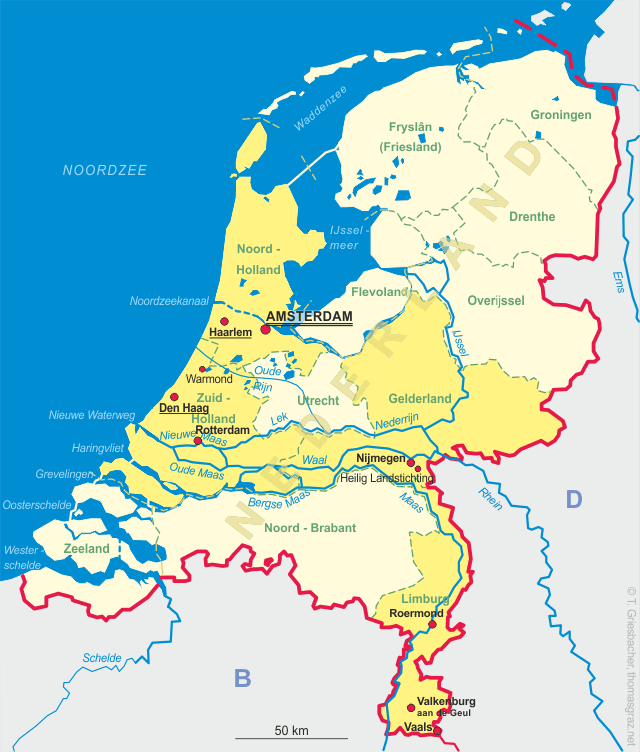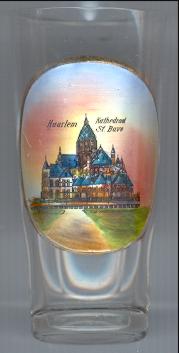
| NEDERLAND | NETHERLANDS |
| Noord-Holland | North Holland |
 Haarlem is one of the oldest cities on the Netherlands and, after Dordrecht, the oldest in Holland.
It was first settled in the 10th century and at that time was called Harulahem, which means something like 'the place built on sand'.
At that time Holland was far more watery then it is now and Haarlem was positioned on a strategic place between mores and streams that would
someday form the Haarlemmermeer, now a polder.
From the 11th until the 13th century Haarlem was the seat of the Graaf (Duke) of Holland. In 1245 Haarlem obtained the rights of a city.
In 1573 Haarlem had to surrender to the Spanish army after a long siege. Over 1,500 civilians, soldiers and protestant clergy where drowned in the river Spaarne.
In the 17th century Haarlem became a center of Art with painters like Frans Hals, Jacob van Ruisdael, Philps Wouverman, Adriaen van
Ostade and the architect Lieven de Key. As a metropole it had already lost its leading role to Amsterdam.
Because Haarlem missed out on most of the industrial innovations of the 19th and 20th centuries, it kept a lot of its old character and today
is a popular tourist destination. Today Haarlem has a population of about 150,000 and is the capital of the Dutch province of North Holland.
Haarlem is one of the oldest cities on the Netherlands and, after Dordrecht, the oldest in Holland.
It was first settled in the 10th century and at that time was called Harulahem, which means something like 'the place built on sand'.
At that time Holland was far more watery then it is now and Haarlem was positioned on a strategic place between mores and streams that would
someday form the Haarlemmermeer, now a polder.
From the 11th until the 13th century Haarlem was the seat of the Graaf (Duke) of Holland. In 1245 Haarlem obtained the rights of a city.
In 1573 Haarlem had to surrender to the Spanish army after a long siege. Over 1,500 civilians, soldiers and protestant clergy where drowned in the river Spaarne.
In the 17th century Haarlem became a center of Art with painters like Frans Hals, Jacob van Ruisdael, Philps Wouverman, Adriaen van
Ostade and the architect Lieven de Key. As a metropole it had already lost its leading role to Amsterdam.
Because Haarlem missed out on most of the industrial innovations of the 19th and 20th centuries, it kept a lot of its old character and today
is a popular tourist destination. Today Haarlem has a population of about 150,000 and is the capital of the Dutch province of North Holland.
 Sint Bavo cathedral [left] was built between 1895 and 1930. In 1948 the church
obtained the rank of a Basilica minor. St. Bavo (AD 589–654), also called Bavon or Allowin, was born as
a nobleman in Brabant. After distributing his money to the poor, he moved to a monastery at Gent,
that later became called by his name. In his later life he lived as a hermit at Mendock and again at Gent. St. Bavo is
the patron of the catholic dioceses of Gent (Belgium) and of Haarlem. His feast day is 1 October.
Sint Bavo cathedral [left] was built between 1895 and 1930. In 1948 the church
obtained the rank of a Basilica minor. St. Bavo (AD 589–654), also called Bavon or Allowin, was born as
a nobleman in Brabant. After distributing his money to the poor, he moved to a monastery at Gent,
that later became called by his name. In his later life he lived as a hermit at Mendock and again at Gent. St. Bavo is
the patron of the catholic dioceses of Gent (Belgium) and of Haarlem. His feast day is 1 October.
(see also list of other basilicae minores depicted on glasses of this collection)
![[scale]](lineal.jpg)